Battlefield 1 Performance In DirectX 12: 29 Cards Tested
High-End PC, 1920x1080
Again, we have too many graphics cards to fit them all into one chart, so GeForces and Radeons are separated. We also know that nobody buys a GeForce GTX 1080 to game at 1920x1080, so we try to keep each resolution’s field relevant.
Low Quality Preset

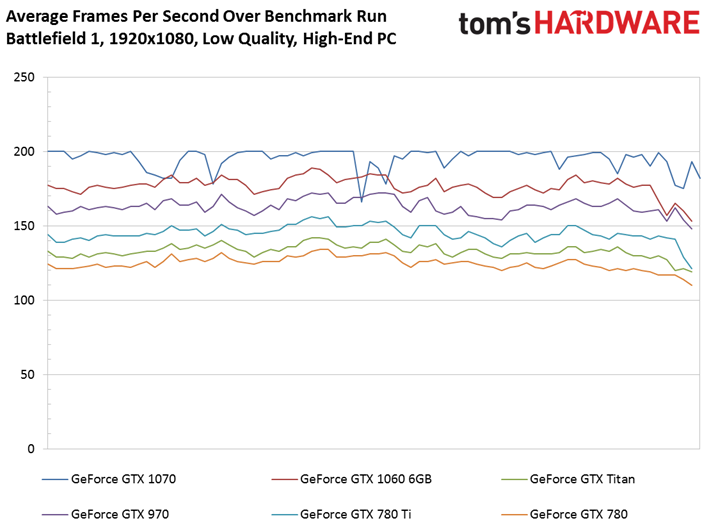



A GeForce GTX 1070 hits the 200 FPS limiter set by default in Battlefield 1, and the rest of the field falls in behind. It looks like this causes some issues with the 1070's frame times, too. But even the slowest card we test, Nvidia’s old GeForce GTX 780, averages nearly 125 FPS using the Low preset.
Gone is much of the inconsistency we saw at the beginning of our runs on the FX-based PC. All of these cards start and finish strong. Perhaps our mainstream GPUs and their modest memory subsystems weren’t to blame, but rather the platform’s limited bandwidth from two channels of DDR3.
We only carry two cards over from the previous pages (GeForce GTX 970 and 1060 6GB), and indeed both were hugely constrained by AMD’s FX CPU. The 970 bags a 50% gain, while the 1060 6GB picks up almost 60% more performance by simply dropping into a Z170A-based motherboard with Intel’s Core i7-6700K installed.





The Radeon R9 390X also bangs against Battlefield’s 200 FPS ceiling, so there’s no point to adding Fiji-based cards to these charts.
Our selection from AMD’s portfolio remains more tightly grouped than the GeForces, bottoming out with the RX 470’s 157 FPS average. All of these cards have plenty of room for more demanding detail settings at 1920x1080.
The Radeon RX 470, R9 390, and RX 480 make a second appearance after first dropping into our FX-based PC. They too were clearly hamstrung by AMD’s previous-gen architecture. The RX 470 enjoys a 41% speed-up, RX 480 rises almost 49%, and the R9 390 jumps by 56%.
Get Tom's Hardware's best news and in-depth reviews, straight to your inbox.
Between the Radeon and GeForce cards, it’s crazy to see just how much upgrading an aging platform can affect performance at 1920x1080—a resolution that the Steam Hardware Survey tells us accounts for 45%+ of respondents. It’ll be interesting to see if this holds up at all during the shift to 2560x1440 on the next page.
Medium Quality Preset

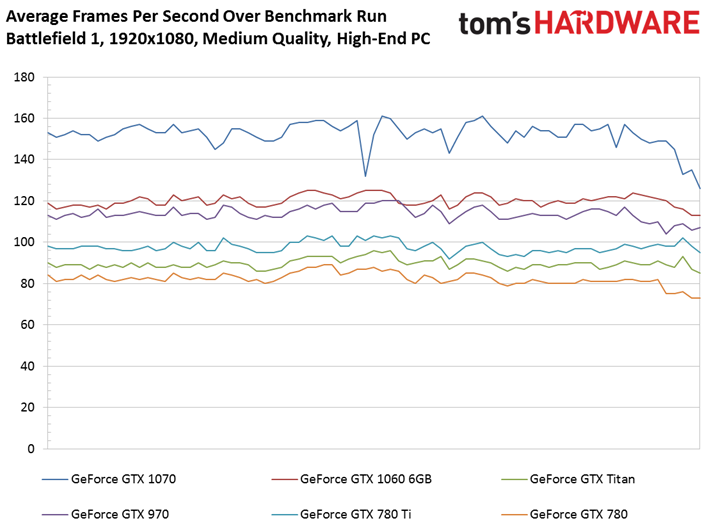



Stepping quality up one notch brings Nvidia’s GeForce GTX 1070 down from Battlefield’s artificial cap. Whereas the 1070 was ~20% faster than the 970 using Low details, it’s now 34% quicker.
Strangely enough, though, the 1070 is the only card in this field that demonstrates frame time spikes through our benchmark sequence. They register as small stutters, which show up on our unevenness metric.





The Radeon cards take a significant performance hit compared to our Low preset results. However, they deliver a smooth, consistent experience. And good news if you’re still gaming on a 2013-era R9 290/290X: the Hawaii GPU is good enough for 100 FPS and up at 1920x1080 on a fast platform.
High Quality Preset


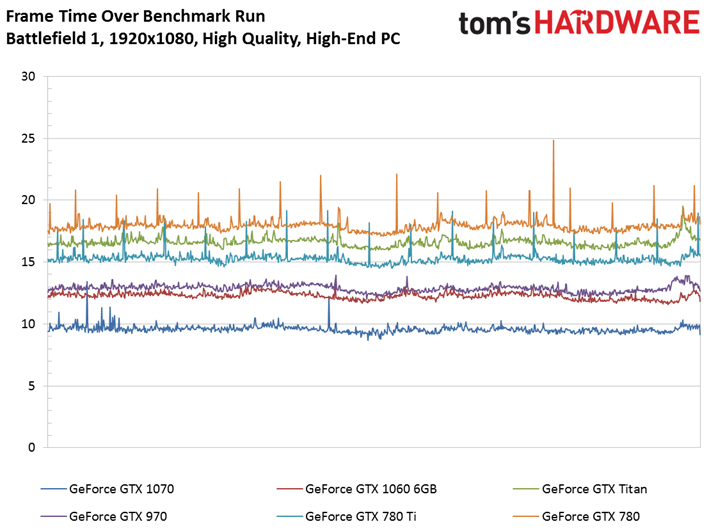


The frame time spikes that plagued GeForce GTX 1070 using the Low and Medium presets disappear when we select High quality. In fact, applying a more demanding workload has a distinctly positive effect on the Pascal-based card’s consistency.
For what it’s worth, the 1070’s lead over its generational predecessor grows to ~37% as we continue moving the detail slider up.
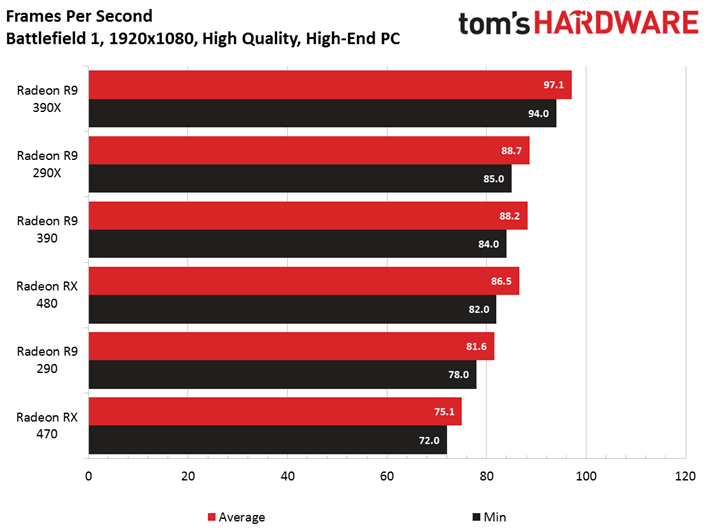
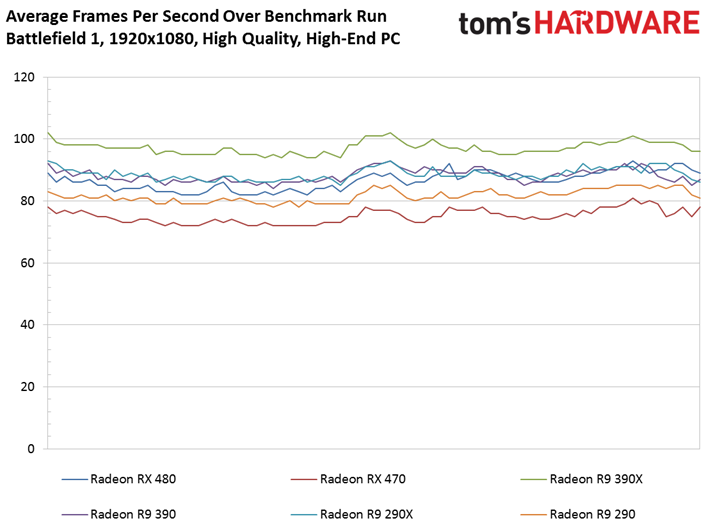



Right down to the Radeon RX 470, AMD’s line-up performs smoothly through our test. All of the cards encounter a frame time spike around the run’s mid-point, but it remains below 30ms in all but one case.
Notably, the Radeon RX 480 8GB is slightly faster than GeForce GTX 1060 6GB, though at this point they’re only separated by about $10.
Ultra Quality Preset




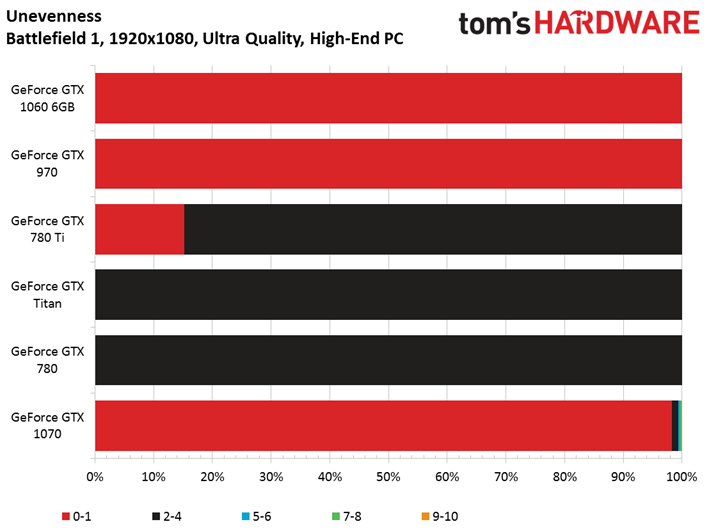
The 1070’s frame time spikes are back, inexplicably, when we specify Ultra quality. They’re significant enough to appear as brief pauses in our unevenness index. And yet, the GTX 1070 posts chart-topping average and minimum frame rates.
A GeForce GTX 780 is fast enough for fairly smooth performance at 1920x1080…but only just, we’d say. Average and, more important, minimum frame rates go up from there, proving that high-end cards from three generations back are still usable at taxing detail settings, so long as you’re willing to compromise on resolution.


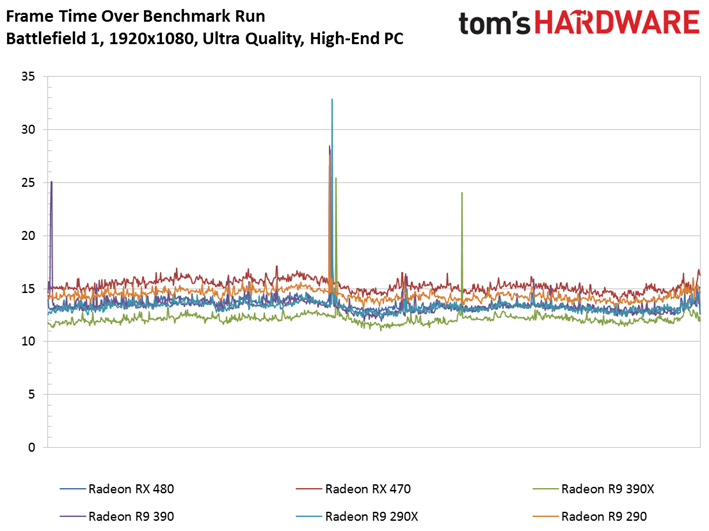


The same goes for AMD’s older Radeons, based on the Graphics Core Next architecture. Radeon R9 290X, Radeon R9 390, and Radeon RX 480 all outperform GeForce GTX 1060 6GB at Battlefield 1’s top quality preset. They generally deliver smooth frame times, too.
MORE: Best CPUs
MORE: Intel & AMD Processor Hierarchy
MORE: All CPU Content
Current page: High-End PC, 1920x1080
Prev Page Mainstream PC, 2560x1440 Next Page High-End PC, 2560x1440-
envy14tpe Wow. The amount of work in putting this together. Thanks, from all the BF1 gamers out there. You knocked my socks off, and are pushing me to upgrade my GPU.Reply -
computerguy72 Nice article. Would have been interesting to see the 1080ti and the Ryzen 1800x mixed in there somewhere. I have a 7700k and a 980ti it would be good info to get some direction on where to take my hardware next. I'm sure other people might find that interesting too.Reply -
Achaios Good job, just remember that these "GPU showdowns" don't tell the whole story b/c cards are running at Stock, and there are GPU's that can get huge overclocks thus performing significantly better.Reply
Case in point: GTX 780TI
The 780TI featured here runs at stock which was 875 MHz Base Clock and 928 MHz Boost Clock, whereas the 3rd party GPU's produced ran at 1150 MHz and boosted up to 1250-1300 MHz. We are talking about 30-35% more performance here for this card which you ain't seeing here at all. -
xizel Great write up, just a shame you didnt use any i5 CPUS, i would of really liked to se how an i5 6600k competes with its 4 cores agains the HT i7sReply -
Verrin Wow, impressive results from AMD here. You can really see that Radeon FineWine™ tech in action.Reply -
And then you run in DX11 mode and it runs faster than DX12 across the board. Thanks for effort you put in this but rather pointless since DX12 has been nothing but pile of crap.Reply
-
NewbieGeek @XIZEL My i5 6600k @4.6ghz and rx 480 get 80-90 fps max settings on all 32 v 32 multiplayer maps with very few spikes either up or down.Reply -
Jupiter-18 Fascinating stuff! Love that you are still including the older models in your benchmarks, makes for great info for a budget gamer like myself! In fact, this may help me determine what goes in my budget build I'm working on right now, which I was going to have dual 290x (preferably 8gb if I can find them), but now might have something else.Reply

